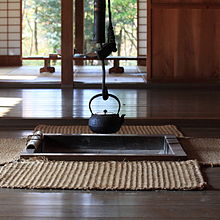Tetsubin

A tetsubin (鉄 瓶) is a Japanese kettle made of cast iron with a lid, a handle and possibly a strainer. This is used to boil hot water and to make tea .
function
A tetsubin is traditionally heated over a charcoal fire , in the art of the Japanese tea ceremony special portable coasters are used for this, e.g. B. the "Binkake" (瓶 掛) or a "Hibachi". A Tetsubin is often elaborately decorated with a relief or pattern on the outside , these can be very different in size and shape. On the inside, Tetsubine are traditionally uncoated and therefore prone to rust if handled incorrectly. A small tetsubin can hold about 0.5 liters of water, larger ones hold up to 5 liters.
Meanwhile, another frequently encountered variant of the inside uncoated teapot is the enamelled Tetsubin Kyushu , which externally resembles a Tetsubin . This type of teapot is glazed with enamel inside to make it more practical for making tea. However, it cannot be used to heat water as this would damage the enamel coating. The different expansion of the materials can then cause cracks. In western regions, these teapots are commonly referred to as tetsubin , although the Japanese call them "Tetsu kyūsu ". (鉄 急 須), or iron teapot to distinguish it from a pure kettle.
The Japanese regions of Iwate Prefecture and Yamagata Prefecture are best known for the manufacture of a tetsubin and cast iron tea products.

history
The historical origin of a tetsubin is not entirely clear, but a Japanese source mentions that the tetsubin probably developed from an older jug called Tedorigama. In the time of Sen no Rikyu (1522–91) there were some developments in the Japanese tea ceremony, the "Chanoyu". The focus was more on the process and philosophy. Details and objects were important to create an atmosphere of "inner peace". Other hypotheses suggest that the popularity of Tetsubins by Sencha , a form of green tea grew. China introduced Sencha to Japan around the middle of the 17th century. In the beginning, Sencha did not have as much reputation as Matcha , the powdered green tea that was common at the time. Throughout the 18th century, people began to drink Sencha in a social setting, for example sharing a cup of tea with friends or family. As more and more people drank sencha , the popularity of the tetsubin grew . In the 18th century, Tetsubine became a standard household appliance for heating water and for making tea. At that time, these most likely did not have an original design, but rather were based on other tea kettles. The five closest relatives of the Tetsubin are the Tedorikama, the Toyama, the Mizusosogi, the Dobin and the Yakkan. Of all of them, the yakkan is most closely related to the tetsubin. The main difference is that the yakkan is made of copper , but the tetsubin is traditionally made of iron . The fact that the tetsubin emerged from the yakkan was possibly because tea drinkers preferred the taste of water from an iron kettle to that of a copper kettle. During the 19th century, tea infusion became more popular and the tetsubin became primarily a status symbol rather than a functional kitchen item . With the increasing use of these kettles, their more elaborate design also increased. In the 19th century, tetsubin designs went from simple iron kettles to intricately engraved masterpieces.
See also
- Japanese tea ceremony
- Kyūsu , Japanese teapots with typical side handles
- Teapot , typical teapot made of different materials
- Kettle (tea kettle), kettle with a spout for heating water
Individual evidence
- ↑ Genshoku Chadō Daijiten原色 茶道 大 辞典: Tankosha, 1975. Japanese illustrated encyclopedia of "the way of tea", entry for "tedorigama".
- ↑ Meaning of "Chanoyu" (English). Retrieved July 16, 2020.
- ↑ History of Tetsubin . Retrieved December 30, 2011.
Web links
- Tetsubin: Japanese Cast Iron Kettle (English speaking)
